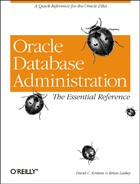A DBA Job Description
Here is a summary of the DBA job description that resulted from the ETS study. Prefix each of the following elements with “An Oracle DBA must be able to....”
- Oracle architecture and options
Demonstrate an understanding of the memory structures and processes that make up an Oracle instance
Demonstrate an understanding of the logical and physical structures associated with an Oracle database
Demonstrate an understanding of PL/SQL constructs (triggers, functions, packages, procedures) and their processing
Demonstrate an understanding of distributed architecture and client server
Demonstrate an understanding of locking mechanisms
- Security
Create, alter, and drop database users
Monitor and audit database access
Develop and implement a strategy for managing security (roles, privileges, authentication)
Demonstrate an understanding of the implications of distributed processing on the security model
- Data administration
Manage integrity constraints
Implement the physical database from the logical design
Evaluate the implications of using stored procedures and constraints to implement business rules
- Backup and recovery
Understand backup options
Develop backup and recovery strategies
Manage the implementation of backup procedures
Recover a database
- Software maintenance and operation
Install and upgrade Oracle and supporting products
Configure the Oracle instance using the initialization parameters
Configure and manage SQL*Net
Distinguish among startup and shutdown options
Create a database
Demonstrate an understanding of the capabilities of underlying operating systems as they relate to the Oracle database
- Resource management
Create and manage indexes
Evaluate the use of clusters and hash clusters
Allocate and manage physical storage structures (e.g., datafiles, redo logs, control files)
Allocate and manage logical storage structures (e.g., tablespaces, schemas, extents)
Control system resource usage by defining proper profiles
Perform capacity planning
- Tuning and troubleshooting
Diagnose and resolve locking conflicts
Use data dictionary tables and views
Monitor the instance
Collect and analyze relevant database performance information
Identify and implement appropriate solutions for database performance problems
Use vendor support services when necessary
Solve SQL*Net problems
In short, the DBA is responsible for installing the Oracle database, keeping it running at peak performance, and attending to the day-to-day administrative needs of a large, complex database.
